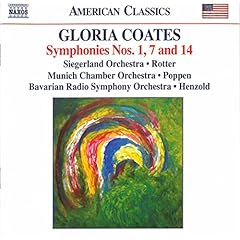| Record companies, artists and publicists are invited to submit CDs to be considered for review. Send to: Jerry Bowles, Editor, Sequenza 21, 340 W. 57th Street, 12B, New York, NY 10019 |
Latest Posts
Ernst Pepping and Allan Pettersson: Moral Dilemmas in Symphonic Music
"The numbers all go to eleven. Look, right across the board, eleven, eleven, eleven and... "
Tell the Birds
Soundtrack to an Apocalypse
Feast Your Ears: New Music for Piano
Gone For Foreign
Fred Lerdahl: Time After Time
Nothing Sacred
Two From Wayne Horvitz
Two Fresh Cantaloupes
Record companies, artists and publicists are invited to submit CDs to be considered for our Editor's Pick's of the month. Send to: Jerry Bowles, Editor, Sequenza 21, 340 W. 57th Street, 12B, New York, NY 10019



|
Archives
Saturday, December 18, 2004
Saturday, December 25, 2004
Friday, December 31, 2004
Wednesday, January 05, 2005
Monday, January 10, 2005
Thursday, January 13, 2005
Thursday, January 20, 2005
Sunday, January 23, 2005
Monday, January 24, 2005
Saturday, January 29, 2005
Wednesday, February 02, 2005
Thursday, February 03, 2005
Monday, February 07, 2005
Tuesday, February 08, 2005
Friday, February 11, 2005
Monday, February 14, 2005
Wednesday, February 16, 2005
Tuesday, February 22, 2005
Monday, February 28, 2005
Sunday, March 06, 2005
Monday, March 07, 2005
Wednesday, March 09, 2005
Sunday, March 13, 2005
Friday, March 18, 2005
Monday, March 28, 2005
Saturday, April 02, 2005
Monday, April 11, 2005
Sunday, April 17, 2005
Tuesday, April 19, 2005
Monday, April 25, 2005
Monday, May 02, 2005
Monday, May 09, 2005
Tuesday, May 17, 2005
Tuesday, May 31, 2005
Monday, June 06, 2005
Thursday, June 16, 2005
Sunday, June 19, 2005
Sunday, July 10, 2005
Wednesday, July 13, 2005
Sunday, July 24, 2005
Friday, July 29, 2005
Monday, August 08, 2005
Monday, August 22, 2005
Wednesday, August 24, 2005
Friday, September 16, 2005
Sunday, September 25, 2005
Tuesday, October 04, 2005
Tuesday, October 18, 2005
Monday, October 24, 2005
Tuesday, November 01, 2005
Monday, November 07, 2005
Saturday, November 12, 2005
Wednesday, November 16, 2005
Tuesday, November 29, 2005
Friday, December 16, 2005
Monday, January 09, 2006
Thursday, January 12, 2006
Thursday, January 19, 2006
Tuesday, January 24, 2006
Thursday, February 02, 2006
Monday, February 13, 2006
Wednesday, February 15, 2006
Wednesday, March 01, 2006
Sunday, March 19, 2006
Sunday, March 26, 2006
Friday, March 31, 2006
Sunday, April 09, 2006
Monday, April 10, 2006
Thursday, April 20, 2006
Friday, April 21, 2006
Thursday, May 11, 2006
Thursday, May 18, 2006
Saturday, May 20, 2006
Friday, June 02, 2006
Tuesday, June 06, 2006
Friday, June 16, 2006
Monday, June 19, 2006
Sunday, June 25, 2006
Monday, June 26, 2006
Monday, July 10, 2006
Thursday, July 13, 2006
Thursday, July 20, 2006
Friday, July 21, 2006
Sunday, July 23, 2006
Thursday, August 03, 2006
Wednesday, August 09, 2006

|
|
Friday, July 21, 2006
Soundtrack to an Apocalypse
 Symphonies Nos. 1, 7 and 14 Symphonies Nos. 1, 7 and 14
Gloria Coates
Siegerland Orchestra - Rotter
Munich Chamber Orchestra - Poppen
Bavarian Radio Symphony Orchestra - Henzold
Naxos
Gloria Coates has often been compared to Penderecki, Górecki and Ives. Known primarily as a symphonic composer, her works explore alternate scales and tuning systems, sometimes juxtaposed with tonal music from existing sources. Coates also experiments with massive amounts of sound, often created by layering her favorite compositional device: the glissando. Her Symphony No. 14 (2002) is particularly Ivesian in its use of quartertones and hymns from two early American composers. The first movement borrows a quote from Supply Belcher’s Lamentation. This melody is introduced after more than five minutes of glissandos played at varying speeds. Both continue together before the tune is again overtaken by wailing glissandos, this time joined by timpani. The second movement pays homage to another New Englander, William Billings, whose dissonant song “Jargon” was penned in reaction to criticism that his music was too consonant. The work concludes with The Lonesome Ones, dedicated to one of Coates’s teachers, Otto Luening.
Also included on this disc is perhaps Coates’s best-known composition, Music on Open Strings (1973, later renamed Symphony No. 1). Dedicated to the memory of Alexander Tcherepnin, another of Coates’s composition tutors, the opening Theme and Transfiguration is based on a Chinese scale. A ponderous melody is stated without adornment, then gradually embellished with glissandos and percussive details until the movement reaches its conclusion with a thunderous climax. The following Scherzo uses the identical pitches, but in the third movement (Scordatura) the instruments gradually return to their conventional tuning. The symphony’s finale, Refracted Mirror Canon for 14 Lines, follows a pattern Coates seems to favor. The movement starts simply, then builds to a cacophonous din before ending abruptly. The CD ends with Coates’s Symphony No. 7 (1990). “Dedicated to those who brought down the wall in PEACE,” it uses a formidable orchestral force that includes brass and percussion.
Since 1969, Coates has spent much of her time in Germany and these works are performed with great conviction by the Munich Chamber, Siegerland and Bavarian Radio Symphony Orchestras. Although this disc spans 30 years of the composer’s career, all three symphonies utilize similar techniques and demonstrate her obsession with the glissando (an enthusiasm that I can’t confess to share). The music often sounds more complex than it actually is, an effect Coates achieves through her use of counterpoint, alternate tunings and sheer volume. Kyle Gann’s excellent liner notes help to shed light on the composer’s processes. Working in the shadow of other more accessible composers, Coates is a prolific symphonist whose music deserves not to be overlooked.
posted by Carol Minor
4:58 PM
|
|




